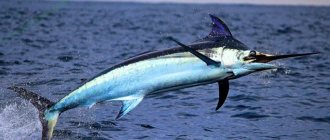Order Cetaceans
This is a large group of mammals, including the largest representatives among the entire class. Nowadays there are 38 genera, united in two suborders: baleen and toothed whales (mystacocetes and odontocetes). These are animals that are fully adapted to living in an aquatic environment. The scientific name of the order comes from Greek and means “sea monster”. And this is not surprising, because whales are the largest mammals on the planet. They have a modified streamlined fusiform body, smooth skin and a thick layer of fat underneath. It protects animals from hypothermia. During the process of evolution, the hind limbs atrophied, and the front limbs turned into giant flippers.
nutrition
Balaenoptera musculus It is a carnivore. Their diet is based almost exclusively on krill, a crustacean found primarily in Arctic seas. Sometimes it may also consume red crab and small fish, including herring and capelin.
They may also have taken some parts of copepods, the species of which vary depending on the habitat.
As part of their diet, the species in the North Atlantic Ocean include Thysanoessa raschii, Meganyctiphanes norvegica, Thysanoessa longicaudata and Thysanoessa inermis.
In the North Pacific, Thysanoessa longipes, Euphausia pacifica, Thysanoessa inermis, Nematoscelis megalops and Thysanoessa spinifera.
In the southern hemisphere, the region is Euphausia superba, Euphausia valentini, Euphausia crystalorophias and Nyctiphanes australis.
Digestive system
Blue whales lack teeth, not beards. They look like brushes and are made of keratin, which gives them their hardness.
The stomach has three chambers: the anterior cavity, the main chamber and the communication channel. The previous chamber stores all the organic compounds that the animal has ingested.
Since there are no glands in this cavity that aid in digestion, food will begin the digestive process thanks to the muscular contractions of the abdominal muscles and the anaerobic bacteria found there.
Once the food bolus reaches the main stomach, pepsin and acids begin to act and continue to degrade the food. These two chambers, the main and the previous ones, work simultaneously with the pylorus of the stomach, since they contain digestive substances and acid glands.
The task of these structures is difficult; digestion of krill, like any other crustacean, involves processing their tough exoskeleton. Once this happens, the gastric juices easily process the soft tissues that form the inside of these crustaceans.
When the krill decomposition process is complete, the digestive material reaches the intestines through a communication channel.
All nutrients are absorbed in the intestines, becoming part of the blue whale's bloodstream. Waste is stored in the colon and then eliminated through the anus.
Feeding by filtration
Since these animals are unable to grasp or chew their prey due to lack of teeth, they rely on filter feed.
Despite its large size, the blue whale feeds on small organisms, especially crustaceans called krill. Experts say one of the reasons Balaenoptera musculus consumes tiny animals may be because your esophagus is very small. They also cannot chew or cut dams into pieces.
The krill are grouped in large banks where they are caught by the blue whale. To do this, it opens its huge mouth, where it consumes not only crustaceans, but also small fish and large amounts of water.
He then partially closed his jaws, pressing his tongue forward, causing water to come out of his mouth. The blue whale subsequently consumes all the remaining animals.
Sometimes you can dive under a cloud of krill and blow bubbles as you spiral. Thus, the krill is forced to go to the center at the moment when the blue whale uses it. It rises to the center, opens its mouth and swallows a group of crustaceans.
Their feeding habits are seasonal. Before migrating to their hatcheries in the warm waters of the equator, blue whales can receive 3 to 4 tons of krill per day. In this way, they store energy to be used when they are in areas where their staple food is scarce.
Top articles: How to identify a dinosaur? Scientific basis for the term "dinosaur"
Baleen whales (toothless): general characteristics
The suborder includes four families, uniting 10 species. These are humpback, blue, bowhead, southern, pygmy, gray whales, fin whale, sei whale, Bryde's whale and small whale. Later in the article we will learn about some of them in more detail. Most representatives of the suborder are cosmopolitan and widely distributed in the waters of the world's oceans. To the question of how many teeth a baleen whale has, we can safely answer: none. All of them underwent significant changes in the process of evolution and turned into special horny plates. They are called “whalebone,” which formed the basis for the name of the suborder. Hard formations are located across the gums one after another with an interval of 0.3-1.2 cm. The apex and inner edges of each plate are split into long, thin bristles. This structure of the jaw apparatus resembles a sieve or filter. The animal swallows a large mass of water with small fish, plankton and crustaceans, and then filters it.
It was unknown in ancient times how many teeth a baleen whale had, but the fact that they existed is an indisputable fact. It is confirmed by the discovery of a fossil species in 2011. A small whale (up to 3 m in length) had large and sharp teeth. This proves that modern species have come a long evolutionary path to the modern structure of the elastic jaw apparatus.
playback
Genitals
The blue whale has the longest penis of any animal species. Cetaceans lack a scrotum, so they have developed other ways to maintain adequate temperature in the testicles, thereby ensuring the viability of sperm.
As blood circulates through the fins, it loses heat, and when it reaches the testicles, it cools the sperm below body temperature.
In females, the vulva is located in the vaginal opening, located at the base of the abdomen. Near the cleft, the skin forms a kind of fold where the nipples meet. With this, the mother will breastfeed the young.
Reproductive process
Blue whales reach sexual maturity at the age of 5-10 years. However, they usually only breed after 3 or 4 years. Before courtship begins, these cetaceans venture into the hot equatorial Arctic waters in search of a mate.
The mating ritual is very similar to dance. Women and men swim together for a while and then dive deep. They then line up belly to belly, so close to each other that they look like one animal. Then the process of copulation occurs where the vagina receives the male sexual organ and the ejaculated sperm can fertilize the egg.
After fertilization, the female returns to her feeding site in the northern part of the Arctic. Since the pregnancy period is long, from 9 months to a year, a woman must save a lot of energy.
That is why, before mating, large reserves of fat accumulated to support his breeding in development and hers.
The blue whale is a placental mammal, so the fetus develops in the mother's womb, in a temporary organ known as the placenta. The growth of the fetus is rapid, starting from the seventh month and can reach almost four meters. The baby is born with a tail, then it quickly comes to the surface to breathe.
Many females breed only once due to a shortage of males, failed fertilization attempts, and the long time required to reproduce. These are some of the reasons preventing the rapid recovery of the species, its terrible destruction during the whaling season.
Breeding
From birth, the blue whale is a very large animal, measuring about 8 meters in size. Breeding occurs by breastfeeding milk with a high fat content, reaching about 180 liters per day. This allows an increase of approximately 90 kg per day. Weaning occurs at the eighth month of birth.
Mother and son remain together for about a year. They later separate, giving the young blue whales their life as an independent animal.
Blue (or light blue) whale
Only one epithet is used for this marine animal in different formulations - “the most”. Its body length reaches 33 meters and its weight exceeds 150 tons. This is the largest animal on modern Earth and, probably, of all that has ever lived on the planet. With such a significant size, the blue baleen whale (whose teeth have turned into a developed filtering apparatus) has a peaceful disposition and feeds exclusively on plankton. Its body is slender, elongated, with a large head; its length makes up 27% of the entire body. Blue whales are long-lived: according to various scientists, their average life expectancy is 40-90 years. This is a cosmopolitan species, its historical habitat covers almost all oceans. Nowadays they can be found extremely rarely, since at a certain period they were on the verge of complete extermination by humans.
Sound signals
Humpback whales are famous for their vocal repertoire, which is believed to play an important role during the breeding season - although female humpbacks produce a variety of sounds, long and melodious songs are performed only by males. The song of a male humpback whale consists of a specific series of frequency-modulated sounds and “phrases” in the range of 40-5000 Hz, which lasts from 6 to 35 minutes; may be repeated over several hours or even days. Males that join females with cubs have been observed to sing longer and more often than others. Songs vary among different populations and may gradually change throughout the mating season; whales perform them both alone and in chorus. Research conducted in 1996 by Australian bioacoustician Michael Noad showed that whales are able to adopt the songs of neighboring pods when they mix with them in their flying areas (in this case, the songs of whales wintering off the west coast of Australia transferred over the summer to a population wintering near east coast). Thus, the singing of whales helps determine the migration routes of these animals. It is unknown whether the songs of humpback whales serve to attract females or to scare off other males and establish a hierarchy between them - according to observations, the songs often end in conflicts with other males. Complex vocalizations were also observed outside the breeding season, in the absence of potential partners (in particular, during migration), which presumably indicates their role in normal communication, or the use of songs for echolocation.
bowhead whale
Baleen whales of this species are inhabitants of the cold waters of the Northern Hemisphere. They also have quite impressive sizes - up to 20 meters in length (females) and 18 m (males), weight from 75 to 150 tons. They dive to great depths (up to 200 meters) and may not emerge for about 40 minutes. They live on average about 40 years. The species has not been studied very well, since it is difficult to observe them in harsh climatic conditions. Feeds on plankton.
Reproduction
These animals have a polygynous reproductive system (some species are monogamous) and males usually mate with more than one female. To attract females, whales often “sing songs.” As a rule, a female gives birth to one calf after a gestation of 10-12 months. Usually the cubs are born in the winter and spring months, and the females bear full responsibility for raising them, and also feed them with their milk for 6-7 months. Females can become pregnant immediately after giving birth, although in other whales there is a gap of 2-3 years. Baleen whales have long lifespans and low neonatal mortality.
Humpback whale (minke whale)
The mammal owes its name to the shape of its dorsal fin, which resembles a hump, and the characteristic habit of arching when swimming. The first photo of our review shows the typical humpback whale jumping out of the water. This is a fairly large whale, up to 14.5 m long, less often 17-18 m, and weighing 30 tons. It differs from other minke whales in body shape and color, thanks to which it is even possible to distinguish individual individuals. The humpback baleen whale is found in all corners of the world's oceans, although populations are sparse. It prefers to stay in shelf and coastal zones, swimming to depths only during migrations. The species has a vulnerable status.
Population and species status
Currently, representatives of this suborder are, to one degree or another, protected due to the threat of extinction. The number of some species does not exceed several dozen individuals. Hunting is prohibited for northern right whales, Japanese whales, humpback whales, sei whales, and blue whales.
Important! Serious threats to the number of baleen whales include damage from collisions with ships during migration, fishing gear, and the negative impact of tourism activities.
Possible dangers include pollution of the world's oceans and a decrease in the food supply due to global changes in climate conditions.
Return to content
Fin whale
It ranks second after the blue whale in size and weight among animals (pictured above). These two species are closely related. Sometimes there are even hybrids. Now two subspecies of fin whales are known: North Atlantic and Antarctic; the existence of a third is possible, according to some scientists. Individuals living in the Northern Hemisphere reach a length of 24 m in adulthood, and residents of the Southern Hemisphere - from 20 to 27 m. This baleen whale, unlike its relatives, willingly lives in small groups (up to 6 animals). The fin whale dives deeply (up to 250 m) and swims quickly, reaching speeds of up to 50 kilometers per hour, and can spend up to 15 minutes underwater without air. Apart from humans, the whale has no natural enemies. However, at the moment the fin whale is rare and is endangered.
Natural enemies
Baleen whales have practically no enemies in nature; perhaps the only danger is to newborn calves from large predators such as sharks or killer whales, as well as weakened or sick animals. But there are known cases when sharks attacked toothless whales, which, due to their slowness, could not quickly repel the enemy. Sharks, by biting off pieces of meat from whales, can weaken the victim, and the bleeding caused by this can attract other sharks . Whales, however, have a chance to fight off attacking predators by striking their tail fin or calling their relatives for help with the sounds they make.
Return to content
sei whale
An endangered species from the minke whale family, growing up to 20 meters in length, weighing about 30 tons. The diet consists mainly of crustaceans and schooling fish (particularly pollock), as well as cephalopods. Baleen whales live to an average age of 60 years. The sei whale dives well to depths of up to three hundred meters and can survive without air for up to 20 minutes. Active extermination of this species began after the number of blue whales and fin whales decreased. In 1986, fishing for it was completely prohibited.
Franz Josef Land
Best places to watch:
waters of Franz Josef Land
Types of whales:
beluga whales, narwhals, bowhead whales, minke whales.
Best season:
summer months coinciding with the period of free navigation
The waters of Franz Josef Land are another point on the map where the migration routes of different whale species simultaneously intersect. So, beluga whales traditionally come here in the summer months. In the waters of the Barents Sea you can also find the amazing “underwater unicorns” narwhals, bowhead whales, which were already mentioned earlier, and minke whales.
Franz Josef Land itself, like Wrangel Island, is notable for the pristine beauty of northern nature untouched by man, with numerous bird colonies, walrus roosts and other Red Book species of flora and fauna.
For reference. Marine animals of the Arctic - narwhal. Interesting facts about narwhals
Narwhals are one of the most amazing, rare and little-studied animals of the sea. In general, the appearance of the narwhal resembles the shape and size of its closest relative, the beluga whale. Its size is 3.5 - 4.5 meters. The difference is in the spotted color and horn.
There is a version that it was the narwhal that served as the prototype of the mythical unicorn, because its horn is exactly the same as in the well-known pictures - long and twisted around its axis in a spiral, and always to the left. In English, one of the names of this animal sounds like this - “sea unicorn”, which means “sea unicorn”. By the way, in the Middle Ages it was widely believed that absolutely all land animals had analogues in the marine environment, hence the many bizarre images of sea creatures in old manuscripts: rooster fish, dog fish, fox fish, and so on.
A narwhal's horn can reach 3 meters in length and weigh up to 10 kg. It usually appears only in males, but in some exceptional cases in females as well. In fact, the “horn” is one of the upper incisors, frolicking into the tusk in a horizontal direction. In total, the narwhal has two upper incisors, one of which is located inside the oral cavity. In the past, people attributed many mythical properties to this horn and hunted narwhals since ancient times precisely for the purpose of obtaining it.
By the way, scientists still do not have convincing hypotheses as to why narwhals need such a bulky structure. Initially, it was believed that it could be used by males as a weapon when winning their chosen one from other gentlemen, but in reality this never happens. Recent studies have shown that inside the entire bone tissue of the tusk is permeated with nerve fibers and endings, accordingly, it is logical to assume that it is used as a kind of tool for obtaining information about the outside world - for example, fluctuations and water temperature. However, in this case it is not clear why females are deprived of such a useful additional sense organ.
Narwhals are as talkative as beluga whales and can make a range of sounds from moos and clicks to creaks and roars.
Narwhals are true northerners who prefer not to leave the waters of the Arctic Ocean and stay near the edge of the Arctic ice. They are found off the coast of Canada, Greenland, as well as in the waters of Spitsbergen, the Franz Josef Land archipelago, Novaya Zemlya, and sometimes off the coast of the Murmansk region and in the White Sea.
Unlike beluga whales, narwhals, in principle, do not tolerate captivity and do not live in an artificial environment for more than 4 months. In the oceans, their average life expectancy reaches 55 years.
In the past, narwhals gathered in huge flocks of several thousand, but today they prefer to stay alone or in small groups of up to 10. Their real number is currently unknown to scientists.
For reference. Minke whale - interesting facts
The northern minke whale (razorback whale, Minke's whale or dwarf minke whale) is the smallest of all minke whales. It reaches about 10 meters in length and, like all its fellow minke whales, is recognizable by the characteristic stripes and folds that run from the underside of the animal’s body - from the head to the navel.
Currently, according to scientists, this species is not in danger of extinction. The northern population of minke whales numbers about 650 thousand. Today, this particular whale remains the main target of whaling in countries where it is still permitted - namely Iceland, Norway and Japan. It is mainly hunted by indigenous peoples according to quotas; there is also fishing for research purposes. Today, about 1,000 minke whales are caught per year.
Bryde's Striper
The whale is medium-sized, up to 14 m in length and weighing up to 25 tons. It has an elongated body of dark gray color with small light spots (pictured). A distinctive feature is three spaced growths at the top of the head. They prefer to live in pairs or small groups. A more or less sedentary species, migrations are short-term and depend solely on the availability of food (mainly fish, cephalopods). The baleen whale is found quite often in all oceans.
Social behavior
Humpback whales do not form permanent groups. With the exception of the mother/calf bond, relationships between individuals are usually unstable and groups quickly disintegrate. In summer, in feeding grounds, humpback whales can feed alone or in small mixed flocks, the size of which depends on the availability of food and the need for coordinated hunting actions. Typically such groups disband within a few hours. Permanent groups that stay together for more than a week have been recorded among whales in the Gulf of Maine and in the waters of Alaska, but their behavior is rather an exception to the general rule. Apparently, these groups do not consist of related individuals.
During migrations and in breeding areas, humpback whales are usually found singly, in trios, or in groups of 2-15 (usually 3-5) individuals. A female and her cub are often accompanied by an “escort”, an adult male, but these pairs are also unstable - other males can join the group and drive away the previous male.
Toothed whales
The modern suborder includes 10 families, including dolphins, narwhals, sperm whales, porpoises, etc. A distinctive feature is the presence of teeth on the jaws. Representatives of toothed whales can be safely called predators, feeding mainly on fish, cephalopods and even other marine mammals. Almost all species are smaller in size than the previous suborder; they are agile and excellent swimmers, with the exception of the sperm whale. It grows up to 20 m in length and weighs about 50 tons. They have a gregarious lifestyle and prefer to stay in large groups.
Another prominent representative of toothed whales is the killer whale (pictured). A cosmopolitan species, a predator with a wide range of nutrition, but each population specializes in a certain type of fish (for example, herring in the Norwegian Sea).
Description
Most hominoids, with the exception of humans and gorillas, are skilled as well as flexible climbers. Gibbons are the most agile arboreal primates of all hominids. They can jump along branches, moving quickly and efficiently through trees.
Compared to other primates, hominoids have a lower center of gravity, a shortened spine relative to their body length, a wide pelvis, and a broad chest. Their overall physique gives them a more upright posture than other primates. Their shoulder blades are located on their back, allowing for a wide range of motion. Hominoids also do not have a tail. Together, these characteristics give hominoids a better balance than their closest living relatives, the Old World monkeys. Hominoids are therefore more stable when standing on two legs or swinging their limbs, and hanging from tree branches.
Hominoids are very intelligent and capable of problem solving. Chimpanzees and orangutans make and use simple tools. Scientists studying orangutans in captivity have noted the primates' ability to use sign language, solve puzzles, and recognize symbols.
Feeding the Cubs
Whales are mammals. Females feed their cubs with thick and high-calorie milk, half consisting of fat and protein. Cetacean milk is cream-colored, has a paste-like consistency, and does not spread in water.
The feeding process takes place underwater. A newborn whale must be able to eat and breathe at the same time. He grabs the nipple for about 5-6 seconds, the female, by contracting her muscles, sends a stream of milk into the offspring’s mouth, he takes a sip and immediately floats up to inhale air. “Gymnastics” continues throughout the entire period of milk feeding - this is how a small whale trains the skill of holding its breath. A blue whale calf drinks up to 200 liters of milk per day. Whales start feeding on their own quite late - for example, the sperm whale remains a “baby” for 13 months.











